Hong Chen
Renmin University of China
Dynamic Mixture of Curriculum LoRA Experts for Continual Multimodal Instruction Tuning
Jun 13, 2025Abstract:Continual multimodal instruction tuning is crucial for adapting Multimodal Large Language Models (MLLMs) to evolving tasks. However, most existing methods adopt a fixed architecture, struggling with adapting to new tasks due to static model capacity. We propose to evolve the architecture under parameter budgets for dynamic task adaptation, which remains unexplored and imposes two challenges: 1) task architecture conflict, where different tasks require varying layer-wise adaptations, and 2) modality imbalance, where different tasks rely unevenly on modalities, leading to unbalanced updates. To address these challenges, we propose a novel Dynamic Mixture of Curriculum LoRA Experts (D-MoLE) method, which automatically evolves MLLM's architecture with controlled parameter budgets to continually adapt to new tasks while retaining previously learned knowledge. Specifically, we propose a dynamic layer-wise expert allocator, which automatically allocates LoRA experts across layers to resolve architecture conflicts, and routes instructions layer-wisely to facilitate knowledge sharing among experts. Then, we propose a gradient-based inter-modal continual curriculum, which adjusts the update ratio of each module in MLLM based on the difficulty of each modality within the task to alleviate the modality imbalance problem. Extensive experiments show that D-MoLE significantly outperforms state-of-the-art baselines, achieving a 15% average improvement over the best baseline. To the best of our knowledge, this is the first study of continual learning for MLLMs from an architectural perspective.
From Failures to Fixes: LLM-Driven Scenario Repair for Self-Evolving Autonomous Driving
May 28, 2025Abstract:Ensuring robust and generalizable autonomous driving requires not only broad scenario coverage but also efficient repair of failure cases, particularly those related to challenging and safety-critical scenarios. However, existing scenario generation and selection methods often lack adaptivity and semantic relevance, limiting their impact on performance improvement. In this paper, we propose \textbf{SERA}, an LLM-powered framework that enables autonomous driving systems to self-evolve by repairing failure cases through targeted scenario recommendation. By analyzing performance logs, SERA identifies failure patterns and dynamically retrieves semantically aligned scenarios from a structured bank. An LLM-based reflection mechanism further refines these recommendations to maximize relevance and diversity. The selected scenarios are used for few-shot fine-tuning, enabling targeted adaptation with minimal data. Experiments on the benchmark show that SERA consistently improves key metrics across multiple autonomous driving baselines, demonstrating its effectiveness and generalizability under safety-critical conditions.
Chain-of-Thought for Autonomous Driving: A Comprehensive Survey and Future Prospects
May 26, 2025Abstract:The rapid evolution of large language models in natural language processing has substantially elevated their semantic understanding and logical reasoning capabilities. Such proficiencies have been leveraged in autonomous driving systems, contributing to significant improvements in system performance. Models such as OpenAI o1 and DeepSeek-R1, leverage Chain-of-Thought (CoT) reasoning, an advanced cognitive method that simulates human thinking processes, demonstrating remarkable reasoning capabilities in complex tasks. By structuring complex driving scenarios within a systematic reasoning framework, this approach has emerged as a prominent research focus in autonomous driving, substantially improving the system's ability to handle challenging cases. This paper investigates how CoT methods improve the reasoning abilities of autonomous driving models. Based on a comprehensive literature review, we present a systematic analysis of the motivations, methodologies, challenges, and future research directions of CoT in autonomous driving. Furthermore, we propose the insight of combining CoT with self-learning to facilitate self-evolution in driving systems. To ensure the relevance and timeliness of this study, we have compiled a dynamic repository of literature and open-source projects, diligently updated to incorporate forefront developments. The repository is publicly available at https://github.com/cuiyx1720/Awesome-CoT4AD.
BehaveGPT: A Foundation Model for Large-scale User Behavior Modeling
May 23, 2025Abstract:In recent years, foundational models have revolutionized the fields of language and vision, demonstrating remarkable abilities in understanding and generating complex data; however, similar advances in user behavior modeling have been limited, largely due to the complexity of behavioral data and the challenges involved in capturing intricate temporal and contextual relationships in user activities. To address this, we propose BehaveGPT, a foundational model designed specifically for large-scale user behavior prediction. Leveraging transformer-based architecture and a novel pretraining paradigm, BehaveGPT is trained on vast user behavior datasets, allowing it to learn complex behavior patterns and support a range of downstream tasks, including next behavior prediction, long-term generation, and cross-domain adaptation. Our approach introduces the DRO-based pretraining paradigm tailored for user behavior data, which improves model generalization and transferability by equitably modeling both head and tail behaviors. Extensive experiments on real-world datasets demonstrate that BehaveGPT outperforms state-of-the-art baselines, achieving more than a 10% improvement in macro and weighted recall, showcasing its ability to effectively capture and predict user behavior. Furthermore, we measure the scaling law in the user behavior domain for the first time on the Honor dataset, providing insights into how model performance scales with increased data and parameter sizes.
Tuning Language Models for Robust Prediction of Diverse User Behaviors
May 23, 2025Abstract:Predicting user behavior is essential for intelligent assistant services, yet deep learning models often struggle to capture long-tailed behaviors. Large language models (LLMs), with their pretraining on vast corpora containing rich behavioral knowledge, offer promise. However, existing fine-tuning approaches tend to overfit to frequent ``anchor'' behaviors, reducing their ability to predict less common ``tail'' behaviors. In this paper, we introduce BehaviorLM, a progressive fine-tuning approach that addresses this issue. In the first stage, LLMs are fine-tuned on anchor behaviors while preserving general behavioral knowledge. In the second stage, fine-tuning uses a balanced subset of all behaviors based on sample difficulty to improve tail behavior predictions without sacrificing anchor performance. Experimental results on two real-world datasets demonstrate that BehaviorLM robustly predicts both anchor and tail behaviors and effectively leverages LLM behavioral knowledge to master tail behavior prediction with few-shot examples.
FlowKV: Enhancing Multi-Turn Conversational Coherence in LLMs via Isolated Key-Value Cache Management
May 21, 2025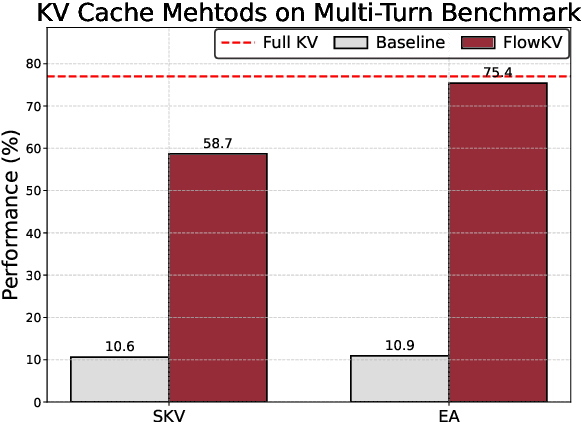
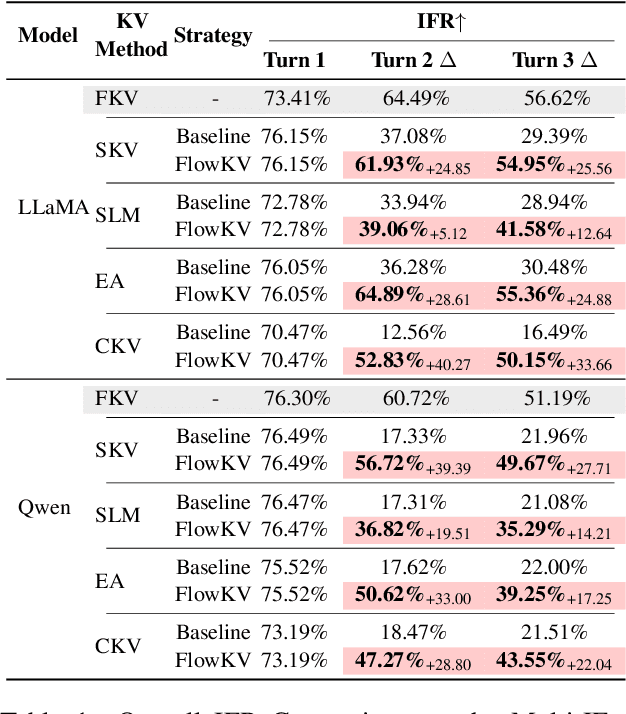
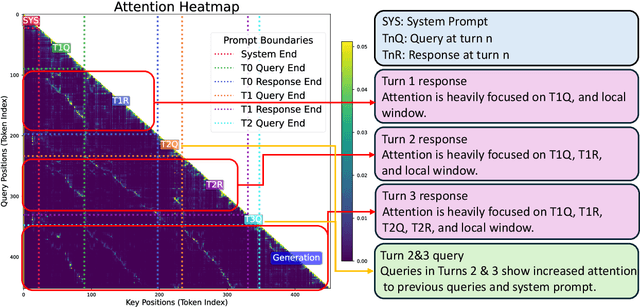
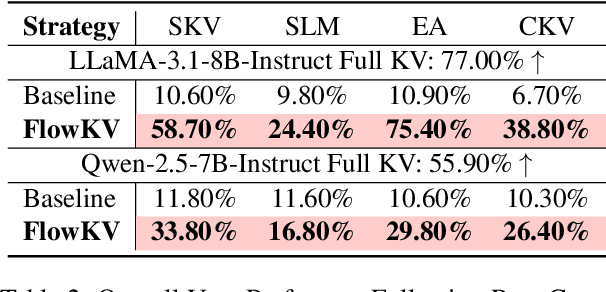
Abstract:Large Language Models (LLMs) are increasingly deployed in multi-turn conversational applications, where the management of the Key-Value (KV) Cache presents a significant bottleneck. The linear growth of the KV Cache with dialogue history imposes substantial computational costs, and existing eviction strategies often degrade performance by repeatedly compressing early conversational context, leading to information loss and context forgetting. This paper introduces FlowKV, a novel \textbf{multi-turn isolation mechanism} for KV Cache management, which can be applied to any KV Cache compression method without training. FlowKV's core innovation is a multi-turn isolation mechanism that preserves the accumulated compressed KV cache from past turns. Compression is then strategically applied only to the newly generated KV pairs of the latest completed turn, effectively preventing the re-compression of older context and thereby mitigating catastrophic forgetting. Our results demonstrate that FlowKV consistently and significantly outperforms baseline strategies in maintaining instruction-following accuracy and user preference retention from 10.90\% to 75.40\%, particularly in later conversational turns.
SSR: Speculative Parallel Scaling Reasoning in Test-time
May 21, 2025Abstract:Large language models (LLMs) have achieved impressive results on multi-step mathematical reasoning, yet at the cost of high computational overhead. This challenge is particularly acute for test-time scaling methods such as parallel decoding, which increase answer diversity but scale poorly in efficiency. To address this efficiency-accuracy trade-off, we propose SSR (Speculative Parallel Scaling Reasoning), a training-free framework that leverages a key insight: by introducing speculative decoding at the step level, we can accelerate reasoning without sacrificing correctness. SSR integrates two components: a Selective Parallel Module (SPM) that identifies a small set of promising reasoning strategies via model-internal scoring, and Step-level Speculative Decoding (SSD), which enables efficient draft-target collaboration for fine-grained reasoning acceleration. Experiments on three mathematical benchmarks-AIME 2024, MATH-500, and LiveMathBench - demonstrate that SSR achieves strong gains over baselines. For instance, on LiveMathBench, SSR improves pass@1 accuracy by 13.84% while reducing computation to 80.5% of the baseline FLOPs. On MATH-500, SSR reduces compute to only 30% with no loss in accuracy.
Unsupervised Learning for Class Distribution Mismatch
May 11, 2025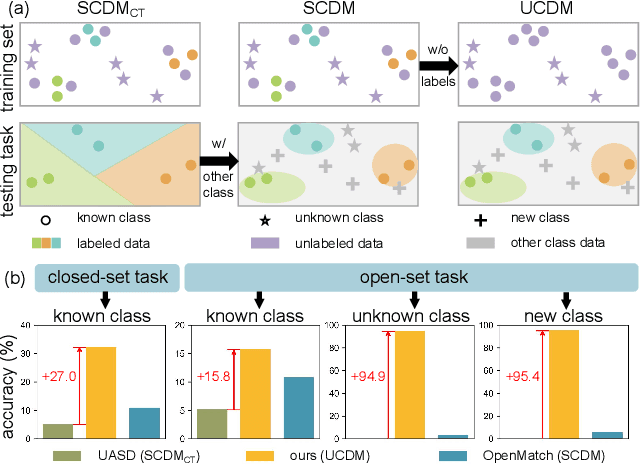

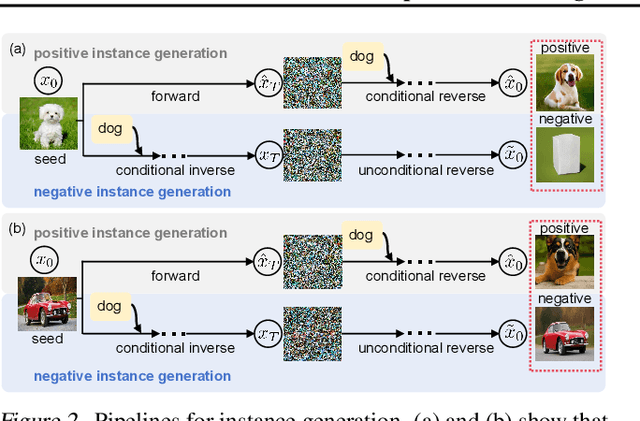

Abstract:Class distribution mismatch (CDM) refers to the discrepancy between class distributions in training data and target tasks. Previous methods address this by designing classifiers to categorize classes known during training, while grouping unknown or new classes into an "other" category. However, they focus on semi-supervised scenarios and heavily rely on labeled data, limiting their applicability and performance. To address this, we propose Unsupervised Learning for Class Distribution Mismatch (UCDM), which constructs positive-negative pairs from unlabeled data for classifier training. Our approach randomly samples images and uses a diffusion model to add or erase semantic classes, synthesizing diverse training pairs. Additionally, we introduce a confidence-based labeling mechanism that iteratively assigns pseudo-labels to valuable real-world data and incorporates them into the training process. Extensive experiments on three datasets demonstrate UCDM's superiority over previous semi-supervised methods. Specifically, with a 60% mismatch proportion on Tiny-ImageNet dataset, our approach, without relying on labeled data, surpasses OpenMatch (with 40 labels per class) by 35.1%, 63.7%, and 72.5% in classifying known, unknown, and new classes.
Modular-Cam: Modular Dynamic Camera-view Video Generation with LLM
Apr 16, 2025Abstract:Text-to-Video generation, which utilizes the provided text prompt to generate high-quality videos, has drawn increasing attention and achieved great success due to the development of diffusion models recently. Existing methods mainly rely on a pre-trained text encoder to capture the semantic information and perform cross attention with the encoded text prompt to guide the generation of video. However, when it comes to complex prompts that contain dynamic scenes and multiple camera-view transformations, these methods can not decompose the overall information into separate scenes, as well as fail to smoothly change scenes based on the corresponding camera-views. To solve these problems, we propose a novel method, i.e., Modular-Cam. Specifically, to better understand a given complex prompt, we utilize a large language model to analyze user instructions and decouple them into multiple scenes together with transition actions. To generate a video containing dynamic scenes that match the given camera-views, we incorporate the widely-used temporal transformer into the diffusion model to ensure continuity within a single scene and propose CamOperator, a modular network based module that well controls the camera movements. Moreover, we propose AdaControlNet, which utilizes ControlNet to ensure consistency across scenes and adaptively adjusts the color tone of the generated video. Extensive qualitative and quantitative experiments prove our proposed Modular-Cam's strong capability of generating multi-scene videos together with its ability to achieve fine-grained control of camera movements. Generated results are available at https://modular-cam.github.io.
QUAD: Quantization and Parameter-Efficient Tuning of LLM with Activation Decomposition
Mar 25, 2025Abstract:Large Language Models (LLMs) excel in diverse applications but suffer inefficiency due to massive scale. While quantization reduces computational costs, existing methods degrade accuracy in medium-sized LLMs (e.g., Llama-3-8B) due to activation outliers. To address this, we propose QUAD (Quantization with Activation Decomposition), a framework leveraging Singular Value Decomposition (SVD) to suppress activation outliers for effective 4-bit quantization. QUAD estimates activation singular vectors offline using calibration data to construct an orthogonal transformation matrix P, shifting outliers to additional dimensions in full precision while quantizing rest components to 4-bit. Additionally, QUAD enables parameter-efficient fine-tuning via adaptable full-precision outlier weights, narrowing the accuracy gap between quantized and full-precision models. Experiments demonstrate that QUAD achieves 94% ~ 96% accuracy under W4A4 quantization and 98% accuracy with W4A4/A8 and parameter-efficient fine-tuning for Llama-3 and Qwen-2.5 models. Our code is available at \href{https://github.com/hyx1999/Quad}{repository}.
 Add to Chrome
Add to Chrome Add to Firefox
Add to Firefox Add to Edge
Add to Edge